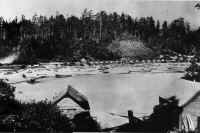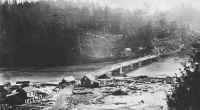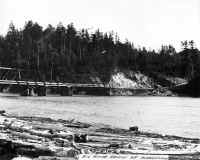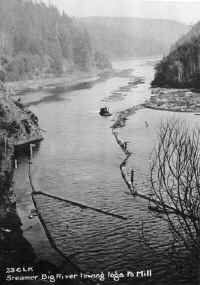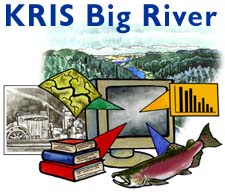Bibliography Background About KRIS
Big River History: Infrastructure - Railroad, Boats, Bridges
Photos provided courtesy of the Mendocino Historical Society and the Held Poage Memorial Home and Research Library. From the collection of Robert Lee. The Bancroft Library at U.C Berkeley also allowed use of a few select photos of the area from their Watkins collection. Further use of photos must be approved by the Mendocino Historical Society or the Bancroft Library. Click on the images to view at full size.
The following excerpts are from Mendocino City, A daily Journal 1852-1938 by W. Francis Jackson. Mendocino Historical Research, Inc. Copyrighted.
October 31, 1852 Jerome B. Ford began surveying a railroad across the beach. (This railroad, used as a tramway between the first mill and east end of the Big River breach, is supposedly the first iron rail laid in California; "laid by David Lansing")
June 30, 1856 William H. Kelly received payment from the Company, for building a scow. (A flat bottom barge, used in transporting lumber from shore to ship. At times, from the mill to a ship and also carried freight up the river)
November 20, 1858 Piers nearly completed. (Tibias Michaels and James P. Kennedy each received by contract $350.00 for having filled the piers with rock. These were timbered framed barriers placed in the river for stopping logs on the drive. Located 3 1/2 miles upriver)
March 22, 1869 Railroad tie-making contract signed between Jerome B. Ford and Sieves & Company (Millions of railroad ties were made on the river, as well as fence posts, pickets for fencing, split shakes, et cetera. Big business with little fanfare)
October 1, 1874 Wilder Pullen injured while reconstructing the Little Northfork logging dam. (He was in charge of refurbishing the river's first such logging device which had been constructed during the Civil War period)
March 6, 1879 Men from town were ordered to the bridge by road commissioner, George Switzer, to save it from being destroyed. (A log jam had built up behind its main pier -- trash from extremely high flood waters upriver)
August 9, 1882 Contract to build bridge across the river was awarded to D. H. Gorrel. (Said bridge was completed for public travel in November. It has installed within it a 40 foot Queen's truss that could be converted into a draw bridge)
May 5, 1883 News item: "The Company laid a short stretch of iron rail on the river". (It was used originally as a tramway. This improvement began at Tidewater, extended almost a mile upriver. It also branched into nearby side gulches)
August 11, 1883 Should Mendocino be supplied with water? was the subject matter discussed at a citizens meeting held at Murray's Hall. (All agreed that water for all purposes should be obtained. 1986, should Mendocino have water?)
July 8, 1888 New steamer Mendocino arrived at Point Arena on her maiden voyage. (She was 124 feet long with a 22 foot beam, and could carry over 300,000 feet of lumber. Her main engine was fitted with a 12 by 24 inch cylinder)
May 21, 1889 Bridge span repair work completed, and was opened for public travel. (Through the years the center or main span of the bridge was a trouble spot, a condition brought on by the middle pier sinking into the river bed.)
Jan 24, 1893 Local citizens voted to sewer Main street during a public meeting held at Murray's Hall. (The sewer line began at the Ford house, went westward on Main Street to a point near Osborn Street, thence due south and into the bay)
Feb. 18, 1893 News item: "Laying of the town's first sewer line was reported as being completed." (An 8 inch terra cotta pipe was laid down Main Street from Ford's house to Lazarus Saloon near Osborn Street, thence south and into the bay)
September 28, 1897 Telephone service to the outside world came into being. (Calls could and were made to San Francisco and elsewhere about the state. There were some difficulties for a short time as everyone wanted to try the system)
October 25, 1897 News by telephone made its debut. (Sunset Telephone company was the originator of the program, having news briefs phoned to the local newspaper each morning. It therefore arrived 24 hours earlier than before.
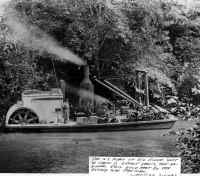 |
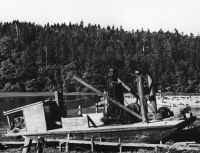 |
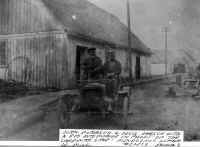 |
|---|---|---|
| The Big River Maru was used to drive log rafts, break up logjams and ferry workers and logging camp residents up and down river. Had a licensed captain and first engineer. | The Big Maru, built in Mendocino in 1920. Craft weight 17 tons with 15 horse power, length 51 feet, breadth 18 feet, depth 3.8 feet | Early automobile, with John Peterson and Louis Larsen. See People page for excerpts about Mr. Larsen. |
May 29, 1900 Caulker arrived from the city to caulk the Big River Maru. (Original purpose for this craft was to aid in the building of a dam at the head of tidewater, one never built. The ship was then converted to move log rafts down the river)
June 5, 1900 Several tons of castings arrived by steamer for the railroad being constructed on the river. (Portions of the new system included sections of the original iron rail that had been laid and used as a tramway in the 1880's)
June 13, 1900 Big River Maru was launched at the mill without fanfare. (It was 40 feet long, 16 feet wide and approximately 3 feet high, with a flat bottom. A stern driven paddle wheel was its motivation. A licensed engineer was required to run the Maru)
July 6, 1900 J.C. Trickler, in charge of the new railroad system, being built on the river, left for the city. (Over 1,000 feet of track had been laid between Fraser's landing to near Laguna Creek, an overall distance of two miles)
August 17, 1900 First railroad locomotive for logging on the river was steamed up and proved ready for service. (the engine was an 1880 17 ton Baldwin, nicknamed the Dinkey. It has a 12 by 16 inch cylinder with a 36 inch stroke, a 0-4-2T)
August 20, 1900 The first train load of logs on the new railroad located on the river, was photographed by F. .J. Chapman. (The smallest log to make the journey from the mouth of Laguna Creek to the earlier log dump was 8 feet in diameter)
July 23, 1901 40 tons of rail arrived to compete railroad extension. (The mill was restarted in anticipation of getting logs needed to keep operating. The extension terminated at the Boom where tidal action would not delay moving logs to the mill)
December 16, 1901 Electrical Company's machinery arrived by the steamer Point Arena
May 19, 1902 Company's 2nd railroad locomotive, a 30 ton Climax arrived on the steamer Phoenix. (It, and a logging donkey for Alfred R. Johnston, were loaded onto a lighter at the ship and taken across the bar (mouth of river) and 5 1/2 miles upriver.)
October 13, 1903 Boyle & Ross logging camp received a wagon load of car trucks for what eventually became the largest logging tramway system in the river. ( C. Edward Boyle and William Ross camp was located at the upper Hatch Gulch)
May 5, 1906 Earthquake-damaged bridge opened to the public, its center pier having collapsed during the April 18th tremor. (The new smoke stack for the mill arrived at Little River. It was 70 feet tall when installed)
October 29, 1907 376 foot long steamer Fitzclarence cleared port, the largest ship alleged to have docked in the Bay. (She could carry 3 million feet of lumber while the brig Glenco, the first ship to leave this harbor, carried only 153,000 feet)
November 2, 1907 Electrical customers began receiving their power requirements from Fort Bragg.. (Mendocino Electric Light & Power Company was meeting with logistical problems, not having enough fuel to serve additional customers)
April 29, 1910 "Peck" Switzer completed hauling a disassembled 35 ton locomotive from Navarro flat. (The location of an old lumber firm. The machine was re-assembled and placed into service on the river, the 3rd such improvement)
June 23, 1910 Company received a new and large Bull Donkey yarder. (It had a piston stroke of 14 inches, its cylinder was 11 inches in diameter. The drums carried 3 miles of cable, enabling the machine to move logs from a point over one mile distant)
July 25, 1912 Five cars of logs were moved over the newly completed 3 mile railroad extension from Laguna Creek to the Little Northfork. (The railroad was extended up into that branch and its tributaries. Used for 24 years of logging)
Feb. 4, 1916 Thomas Ellison completed a new road into Little Northfork from the Little Lake road, going down Thompson Gulch. (He was to establish a tanbark camp near the mouth, and in his first season, gathered over 300 cords)
June 4, 1919 Company's new gasoline speeder for the railroad arrived and was taken up the river on the Maru. (It was placed on the tracks, and, under its own power, traveled to Boyle's logging camp. Used to transport men to/from work)
December 6, 1919 The new Maru, Big River #2 was launched at the mill. (Its designer and builder was John Peterson. The principal difference between the new craft and the old one was the shed roof over the paddle wheel)
December 29, 1919 The new Maru, Bib River #2, made a fast run to the Boom, taking 25 minutes on a slack tide. (It was the last such type of craft. Some of its remains still rest n the north bank mudflat, across the river from Iron Pin Hole.
August 7, 1921 First tractor used for logging on the river, a 14 ton Holt, broke through the bridge on its way to Charles B. Mallory's logging camp, coincidentally known as the River camp. (This machine was Mallory's personal property)
June 24, 1926 Marie Bakke, the third largest ship ever to enter the bay, taking on a cargo of railroad ties. (In 1909 the second largest ship, Oswestry, at 353 feet long, could and did take on one and one half months of the mill's lumber output)
December 30, 1926 The phrase Old Boom came into being as the last of four piers which formed it was removed from the river. (A new Boom had been completed. The old boom log storage area had filed with debris after 60 years of holding logs)
April 27, 1936 Construction of a logging road began, on which the first trucks would be used in transporting logs. (A. J. Rawley, contractor, followed the railroad in Laguna Creek, thence over a divide to the Lower Ranch and nearby gulches)
August 6, 1936 First logs moved by truck arrived at the mouth of Laugna Creek. (Joe Lenhares and John Rodgers unloaded the truck. Edward Mathews and Martin Rodgers reloaded the logs onto the train.)
September 22, 1936 Edward Mathews injured in transferring logs from a truck to one of the last trains ever to haul logs on the river.
May 7, 1937 First truck load of logs was transported on the logging road extension from Laguna Creek to near the former railroad log dump. (From this point, the logs were handled as before, rafted and taken to the mill pond)
August 10, 1938 Second part of the Simon Benson log raft was towed into the Bay. (The raft being towed had been nearly 1,000 feet long, 52 feet wide, containing up to 5 million feet of logs. Many such rafts passed by this place).
Infrastructure - railroads, boats, bridges, etc.
Events - floods, storms, shipwrecks, etc
Logging / Mills - operations and events at mills, logging activities
Also see, Big River Was Dammed (excerpts) and Fish stories from the past
